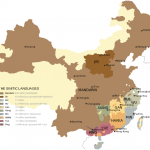 The HSK (汉语水平考试, Hànyǔ Shuǐpíng Kǎoshì) is the dominant proficiency test for learners of Chinese. As such, its main purpose is to assess the language proficiency of foreign students, yet many use it for more than that, regarding the HSK more like a roadmap to learning Chinese.
The HSK (汉语水平考试, Hànyǔ Shuǐpíng Kǎoshì) is the dominant proficiency test for learners of Chinese. As such, its main purpose is to assess the language proficiency of foreign students, yet many use it for more than that, regarding the HSK more like a roadmap to learning Chinese.
Is this a good idea?
If you use the HSK as a roadmap, is there anything you should keep in mind?
I’ve been pondering these questions ever since I realised that many students structure their entire learning experience around the HSK. At first, this seems odd, considering that it’s just a test, not a curriculum. Sure, it’s great to assess your level regularly to benchmark your progress, but is it wise to focus on HSK beyond that?
Let’s have a look!
Tune in to the Hacking Chinese Podcast to listen to the related episode:
Available on Apple Podcasts, Google Podcasts, Overcast, Spotify, YouTube and many other platforms!
HSK? Which HSK?
Before we try to answer the questions posed above, it’s good to explain the basics of the HSK. In essence, it’s a proficiency test based on the Chinese Proficiency Grading Standards for International Chinese Language Education (国际中文教育中文水平等级标准, guójì zhōngwén jiàoyù zhōngwén shuǐpíng děngjí biāozhǔn), administered by Hanban (汉办, Hànbàn), an institution affiliated with the Chinese Ministry of Education.
The standards underlying the exam was changed in 2021, but the lower levels of the exam (1-6) still haven’t been updated to reflect this, while the new higher levels (7-9) have been rolled out. I wrote more about the new HSK 3.0 here:
Beyond the standards and the test itself, there are also various support structures that use the HSK name, including textbooks and courses. These are not strictly speaking part of the exam, but can make HSK more resemble a curriculum. Beyond the name and the close adherence to the standard, these learning materials have no obvious benefit over other learning materials. A textbook or course isn’t better just because it has an official stamp of approval. And of course, anyone can create learning materials aimed at a specific HSK level!
HSK as a Chinese proficiency test
Before we go into using HSK as a roadmap to learning Chinese, let’s have a quick look at a couple of obvious reasons why HSK can be useful for learners of Chinese:
- HSK offers written proof of what you have learnt, which is necessary in some situations. If you’re applying for a job or an educational program that requires a certain level of Mandarin, taking the test can prove to an employer or institution that you have what it takes. Admittedly, this is not very common and usually only applies at the more advanced levels. Lower levels can still be useful to skip levels in a program for learning Chinese or accessing more advanced courses. Learn more about studying Chinese when your grades matter here.
- HSK offers objective benchmarking of your current proficiency level. How useful this is depends on how closely your own goals for learning Chinese matches those that underlie the proficiency standards. I think the HSK does a good job of evaluating basic listening and reading skills, so if you take the exam twice with six months in-between and see a significant improvement, this is likely a sign that you actual ability has improved as well,. However, HSK doesn’t do as well with active language usage, including vocabulary and grammar. Read more about benchmarking your progress here: Benchmarking progress in Chinese to stay motivated.
Still, as a proficiency exam, the HSK does okay. I think the new (3.0) standards are considerably better than the old (2.0 standards, and it’s good to see that the levels are brought closer to other international standards for language proficiency, such as the Common European Framework of Reference for Languages (or CEFR; check this article about how to self-assess your proficiency using this standard).
Level 6 in HSK 2.0 was nowhere near the advanced levels of CEFR (C1 and C2), and even though I have yet to see analyses of how HSK 3.0 compares, it’s certainly an improvement. It’s likely that the new advanced level (7-9) can really be used to show that you have full working proficiency in Chinese, which wasn’t possible before. This makes the HSK more useful as a proficiency exam! It also allows more advanced students to benchmark their progress.
HSK as a roadmap to learning Chinese
 As I said in the introduction, many students use HSK as something more than just a test. If you browse online forums, message boards and chat rooms, you will often come across students who are “working their way through HSK 4” or are dismayed by the increase in difficulty of HSK 3.0. This indicates that they are viewing it as a roadmap to learning Chinese, a curriculum if you will.
As I said in the introduction, many students use HSK as something more than just a test. If you browse online forums, message boards and chat rooms, you will often come across students who are “working their way through HSK 4” or are dismayed by the increase in difficulty of HSK 3.0. This indicates that they are viewing it as a roadmap to learning Chinese, a curriculum if you will.
At first, this might seem backward, but there are some good reasons for using the HSK as a curriculum:
- HSK provides well-needed structure if you don’t have an actual curriculum – Learning Chinese as an independent learner can feel chaotic and frustrating. Take the example of vocabulary: How are you supposed to know what words you’re supposed to learn first? Well, you could read my advice on it, but let’s face it, it’s easier to refer to an official list of characters and words, and start working your way through it. While you could use the self-assessment tools for the CEFR I linked to above, knowledge of vocabulary and grammar points is easier to measure!
- HSK focuses on language that is useful for the average learner of Chinese – In general, the vocabulary and grammar points in HSK are aligned with the needs of a typical foreign student. This is an important advantage over using frequency lists, which tend to emphasise written, formal language over spoken, informal language. Some words, such as “train station” or “toilet” might not be that frequent in written Chinese, but they are disproportionally important to know for a student planning a trip to China.
- HSK offers structure for other learning resources – People who say that they “work their way through HSK 4” don’t necessarily mean that they are going through the vocabulary lists in alphabetical order (which is a really bad idea, by the way). Because HSK is so dominant, almost all learner resources use the HSK as a reference, so a video might be aimed at HSK 2 or a short story suitable for HSK 5. This labelling might not always be entirely accurate, but it’s at least brings some order to the jungle of online resources for learning Mandarin. The only other option is to use bigger categories, such as beginner, intermediate and advanced, which is what I do on Hacking Chinese Resources, where I’ve gathered more than 500 resources and tagged them all by level, topic and type.
As we can see, there are good reasons to use the HSK as more than just a proficiency test! Still, I think this is mostly misguided, and students take the HSK much too seriously.
The (road)map is not the territory
Let’s have a closer look at students who are dismayed or even upset that the HSK standards are changing, so the new 3.0 is considerably harder than the old 2.0. There are few cases where this is a reason for legitimate concern, but this is extremely rare. As I explained in my article about HSK 3.0:
There are many students who care a lot about HSK, probably because it provides a roadmap to learning Chinese. That’s fine! But remember, the HSK is just a yardstick against which you can compare certain aspects of your proficiency; it’s not the language itself!
Changing the yardstick does not change what it measures. I’ve seen many students who are dismayed by the fact that the level they are working towards now will be equal to a lower level according to the new standard. For example, the current HSK 3 contains roughly the same amount of vocabulary as the new HSK 1 (600 and 500 words respectively). If we measure only vocabulary, someone currently at HSK 3 would then in theory be “downgraded” to HSK 1.
So what? Your Chinese proficiency does not change because of how many words are listed under a certain number in an official document. The language itself does not suddenly become harder because more is required for a certain level on an exam. Your ability to communicate in Chinese is the same on June 30th as it is on July 1st. Nothing has changed.
Being upset about one’s ability being “downgraded” from HSK 3 to HSK 1 is a bit like a golfer being disappointed that their drive is suddenly shorter when measured in metres instead of yards after taking a flight to a European tournament: “Oh, I guess I’m 10% worse than I was yesterday.” That’s clearly nonsense, and so is worrying about your Chinese being “downgraded”.
The way we measure something like this does not change the thing measured. The map is not the territory. A proficiency test is not the language itself.
The only case where this does not apply is if you truly need the certificate itself, because since the higher levels are more advanced than before, it becomes easier for companies and institutions to also raise their requirements. Still, bear in mind that most serious companies and institutions will check your actual proficiency, beyond any certificate you might or might not have!
8 reasons HSK isn’t a good roadmap to learning Chinese
So, finally, here things to think about before you start treating HSK as roadmap or curriculum:
 Not communicative – Language learning is not about memorising characters, words and grammar points, it’ about using these to communicate. This means that they need to be embedded in a communicative context to make sense, and you need to be able to deal with that in real-world situations to truly say you know Chinese. The HSK does not test this.
Not communicative – Language learning is not about memorising characters, words and grammar points, it’ about using these to communicate. This means that they need to be embedded in a communicative context to make sense, and you need to be able to deal with that in real-world situations to truly say you know Chinese. The HSK does not test this. Mostly about receptive skills – While there are speaking and writing parts too, most people only take the version of the exam that doesn’t include any live interaction with a human interlocutor. This is interesting, considering that this is the very purpose for which many people learn Chinese in the first place! It’s of course understandable, because such exams are also much more expensive. Remember, language is communication, not an abstract subject to study.
Mostly about receptive skills – While there are speaking and writing parts too, most people only take the version of the exam that doesn’t include any live interaction with a human interlocutor. This is interesting, considering that this is the very purpose for which many people learn Chinese in the first place! It’s of course understandable, because such exams are also much more expensive. Remember, language is communication, not an abstract subject to study. Heavy focus on vocabulary and grammar points – A vast majority of the document describing the standards contains lists of characters, words and grammar points. This can give the impression that if you’ve learnt (whatever that means) a certain number of words, your Chinese will be at a certain level. This is definitely not true! Fluency is more about being quick and skilled with using what you know.
Heavy focus on vocabulary and grammar points – A vast majority of the document describing the standards contains lists of characters, words and grammar points. This can give the impression that if you’ve learnt (whatever that means) a certain number of words, your Chinese will be at a certain level. This is definitely not true! Fluency is more about being quick and skilled with using what you know.  Even so, some vocabulary is left out – Given that so much space is given to what words students should know, it’s interesting to note that some categories of words are left out, even if they are useful for learners. For HSK 2.0, this includes words for foreign things (e.g. 棒球, “baseball”, 女王 “queen”), names (e.g. 美国, “USA”, 日本, “Japan”) and profanity (even mild ones, such as 傻瓜, ”fool”, 笨蛋, “idiot”).
Even so, some vocabulary is left out – Given that so much space is given to what words students should know, it’s interesting to note that some categories of words are left out, even if they are useful for learners. For HSK 2.0, this includes words for foreign things (e.g. 棒球, “baseball”, 女王 “queen”), names (e.g. 美国, “USA”, 日本, “Japan”) and profanity (even mild ones, such as 傻瓜, ”fool”, 笨蛋, “idiot”). Speed matters (too much) – As I have explained elsewhere, speed matters a lot on proficiency exams (not just the HSK). This is not strange, but it’s possible to be quite good at reading and still fail an advanced reading exam, not because you don’t understand the text, but because you read too slowly. Now, it’s fair to say that being slow means you haven’t read enough to pass the exam, but it’s also possible to argue that speed is not very important for what you want to use Chinese for.
Speed matters (too much) – As I have explained elsewhere, speed matters a lot on proficiency exams (not just the HSK). This is not strange, but it’s possible to be quite good at reading and still fail an advanced reading exam, not because you don’t understand the text, but because you read too slowly. Now, it’s fair to say that being slow means you haven’t read enough to pass the exam, but it’s also possible to argue that speed is not very important for what you want to use Chinese for. Focusing on some topics over others – Since the HSK is a standardised exam, it needs to stick firmly in the mainstream when it comes to choice of topics to cover. This is okay at the lower levels, because there’s only one way to be a complete beginner. There are infinity ways to be an intermediate learner, though, and the chances that HSK focuses on the right topics for you decreases the higher up the ladder you climb. It’s incredibly unlikely that the HSK 7-9 word lists contains words that are more useful for you than words you would encounter simply by using Chinese in contexts that matter to you.
Focusing on some topics over others – Since the HSK is a standardised exam, it needs to stick firmly in the mainstream when it comes to choice of topics to cover. This is okay at the lower levels, because there’s only one way to be a complete beginner. There are infinity ways to be an intermediate learner, though, and the chances that HSK focuses on the right topics for you decreases the higher up the ladder you climb. It’s incredibly unlikely that the HSK 7-9 word lists contains words that are more useful for you than words you would encounter simply by using Chinese in contexts that matter to you. Using only standard language – China is huge and most people have’t grown up with Mandarin as their mother tongue. Today, almost all learn the standard language in school, so you can expect younger people to have a good grasp of it, but this doesn’t mean that their topolects (regional variants) are eradicated. This means that when you speak Mandarin with real people in China, they will not stick to standard language (the only person who does that is your Chinese teacher). You will hear many different accents, regional variants of words and unorthodox grammar everyday, all the time! None of that is in the HSK.
Using only standard language – China is huge and most people have’t grown up with Mandarin as their mother tongue. Today, almost all learn the standard language in school, so you can expect younger people to have a good grasp of it, but this doesn’t mean that their topolects (regional variants) are eradicated. This means that when you speak Mandarin with real people in China, they will not stick to standard language (the only person who does that is your Chinese teacher). You will hear many different accents, regional variants of words and unorthodox grammar everyday, all the time! None of that is in the HSK. Test taking skills matter too much – If you want to get a good result on the HSK, the best thing you can do is to take as many mock exams you can, or if you can afford it and it’s practical, register for as many real exams as you can. The practice effect is real, and test-taking is a skill in itself. However, being familiar with the test and having developed good strategies to deal the different parts of the exam has zero bearing on your actual language proficiency! Of course, if your grades matter to you, you should use this to your advantage, but don’t fool yourself into believing that HSK and language proficiency are the same thing!
Test taking skills matter too much – If you want to get a good result on the HSK, the best thing you can do is to take as many mock exams you can, or if you can afford it and it’s practical, register for as many real exams as you can. The practice effect is real, and test-taking is a skill in itself. However, being familiar with the test and having developed good strategies to deal the different parts of the exam has zero bearing on your actual language proficiency! Of course, if your grades matter to you, you should use this to your advantage, but don’t fool yourself into believing that HSK and language proficiency are the same thing!
In essence, passing the HSK proves you can do some things, but these may or may not be the things you actually want to use the language for.
If someone does pass a certain level, it tells you quite a lot, though. For example, someone who does well on the HSK 7-9 reading or listening is guaranteed to be fairly good at reading and listening, there’s simply no way to fake that.
However, if someone does not pass a certain level, this doesn’t tell you much at all. For example, someone might be good at Classical Chinese poetry, but read modern Chinese too slowly to be able to pass an advanced reading test, or someone might amazingly good at communicating with native speakers in real-life situations, but not used to formal listening tests and thus fail the exam.
I’m not saying you should never use the HSK for anything beyond benchmarking and certifying your Chinese proficiency, but I am saying that you need to be aware of the above issues if you treat HSK more like a curriculum.
How you measure progress influences how you study
Another danger is that if you take the HSK too seriously, the way you measure your proficiency will start influencing how you study. This might result in strategies like:
- Focusing only on words that are included in the official lists, because other words won’t help you on the exam.
- Learning only to write by hand (if that indeed is on the new exam), but ignoring reading handwriting, because that won’t be
- Listening to only perfectly standard Mandarin, because no accented speech will ever appear on the official exam
These are severely misguided, yet this is where you will end up if you let the way you measure progress influence you too much, a problem I’ve written more about here: The importance of counting what counts when learning Chinese.
The importance of counting what counts when learning Chinese
Conclusion: Using HSK as a roadmap to learning Chinese
I think we can summarise this discussion about the HSK in two important insights:
- Language is about communication; the HSK is not. This is mostly true for the exam itself, but it’s completely true for the vocabulary and grammar lists. You can memorise every single word without being able to communicate in Chinese, but you can also be good enough at Chinese to be able to deal with any everyday situation while still failing the exam.
- The HSK can still be used for goal-setting, motivnation and structure, but only if you keep what I’ve said in this article in mind and don’t take the test too seriously. There’s nothing wrong with thinking the HSK is important, but don’t forget that it’s just a proficiency test! As I’ve said already, it’s highly unlikely that your goals for learning Chinese overlap perfectly with the standards that HSK is based on. You should be in control of your own learning!
Have you taken the HSK? Are you using it as just a proficiency test? Or do you use it as a roadmap too? Let me know what you think in the comments below!
